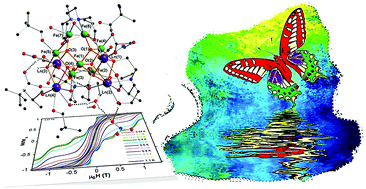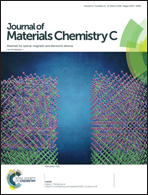Influence of lanthanides on spin-relaxation and spin-structure in a family of Fe7Ln4 single molecule magnets†‡
Abstract
A family of isostructural undecanuclear 3d–4f coordination clusters of formula [FeIII7LnIII4O4(OH)3(tea)2(Htea)3(Piv)7(H2O)2(NO3)3], where Ln = Y (1), Gd (2), Tb (3), Dy (4); PivH ≡ pivalic acid and H3tea ≡ triethanolamine, was synthesised. The central Fe7 core of the coordination cluster can be described in terms of two {Fe4O2} butterfly motifs sharing a common body Fe atom. The two Fe4 mean-planes subtend a dihedral angle of ca. 72°. The Tb (3) and Dy (4) compounds show Single Molecule Magnet (SMM) behaviour as confirmed by ac-susceptibility and μ-SQUID measurements. Furthermore, 57Fe Mössbauer spectra of 1–4 confirm the presence of high-spin FeIII sites. The spectra of all complexes in the high temperature range (30–300 K) show broad overlapping doublets which were assigned to the body and wing-tip pairs of metal ions within the Fe7 core. The low temperature Mössbauer spectra show dependence on the nature of the rare-earth metal as a result of its interaction with the iron sites. Thus, we observed a transition from fast (2), to intermediate (1) and very slow (frozen) (3, 4) spin fluctuation phenomena in these compounds.

- This article is part of the themed collections: International Year of the Periodic Table : Lanthanides for Precision Therapy and Beyond and In memory of Paul O’Brien


 Please wait while we load your content...
Please wait while we load your content...
